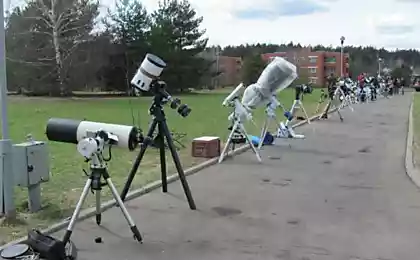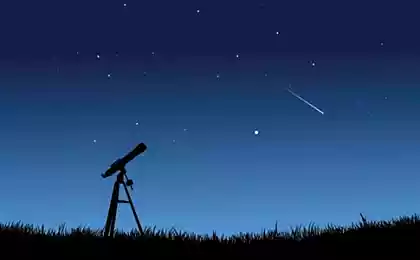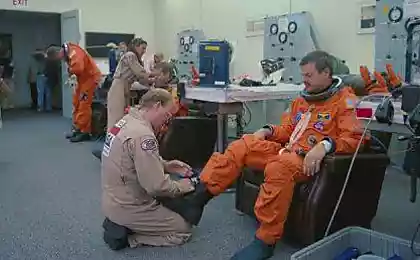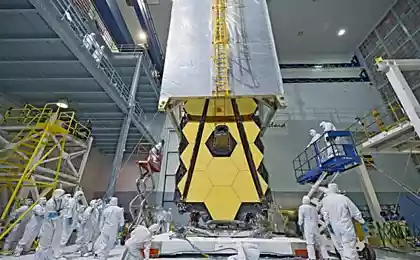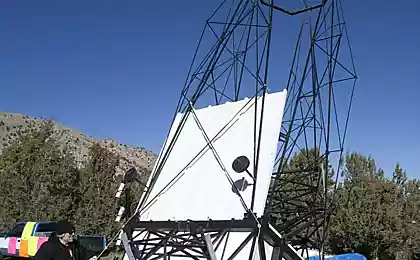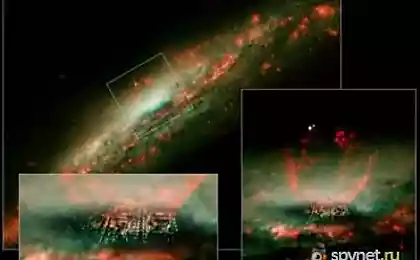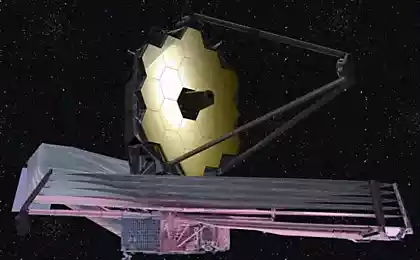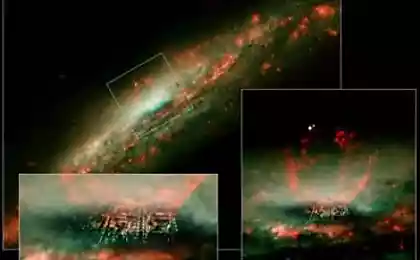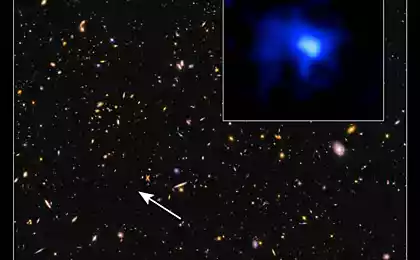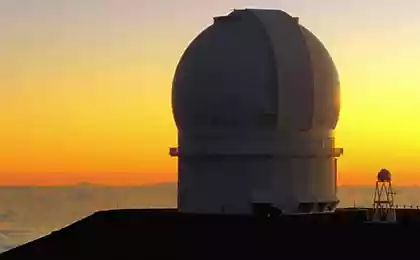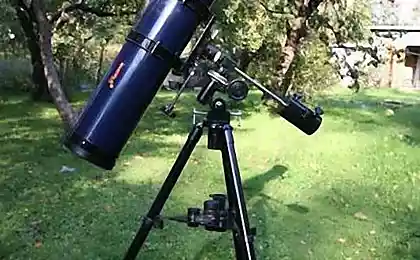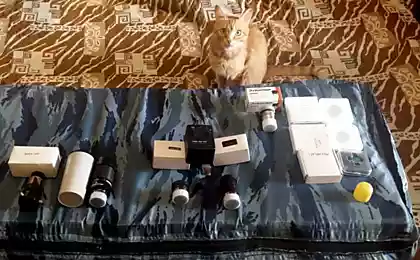1987
With the Hubble Space Telescope
NGC 5194
This large galaxy may have been the original spiral nebula. It is clearly seen that her arms and dust band pass in front of satellite galaxies (left). This pair is located about 31 million light-years and officially belongs to the small constellation Canes Venatici.
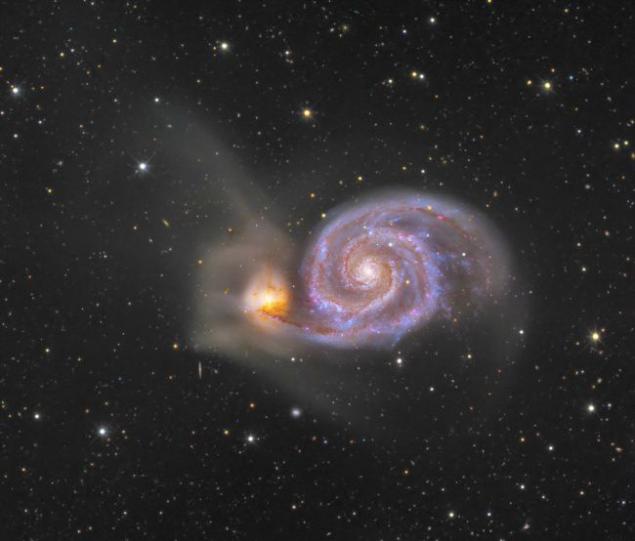
Spiral Galaxy M33
The average size galaxy M33 is also called the Triangulum Galaxy for the constellation in which it resides. It is about 4 times smaller in radius than our Milky Way Galaxy and the Andromeda Galaxy. M33 is close to the Milky Way, its angular size of twice the size of the full moon, and it is perfectly visible with good binoculars.
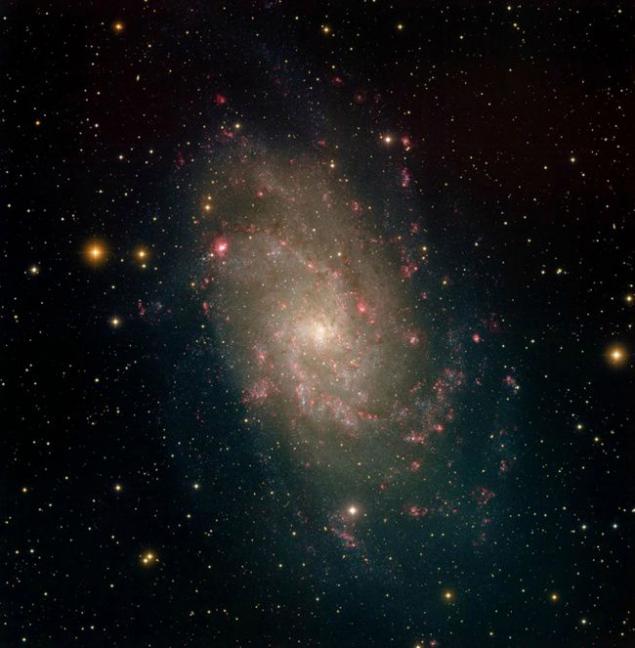
Stephan's Quintet
This group of galaxies called Stephan's Quintet. However, only four galaxies of the group are located in three hundred million light-years from us, participate in the cosmic dance, then approaching, remove from each other. Excess find quite simple. Four interacting galaxies have a yellowish tint and curved loops and tails, the shape of which is due to the influence of the devastating tidal gravitational forces. Bluish galaxy is located on the top left of the picture is much closer than the others, just 40 million light years from us.

Andromeda Galaxy
Andromeda Galaxy - the closest to our own Milky Way from giant galaxies. Most likely, our galaxy looks about the same as this one. Hundreds of billions of stars that make up the Andromeda galaxy, together give a visible diffuse glow. Individual stars in the image are actually stars in our galaxy located much closer to the remote object.
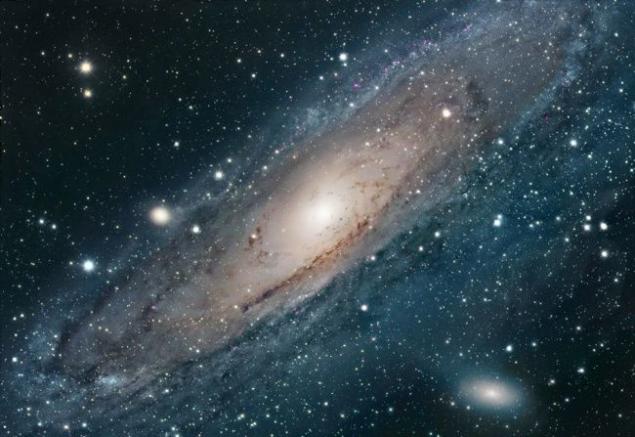
The Lagoon Nebula
In bright Lagoon Nebula is a wide variety of astronomical objects. Particularly interesting objects are bright open cluster of stars and a few active regions of star formation.
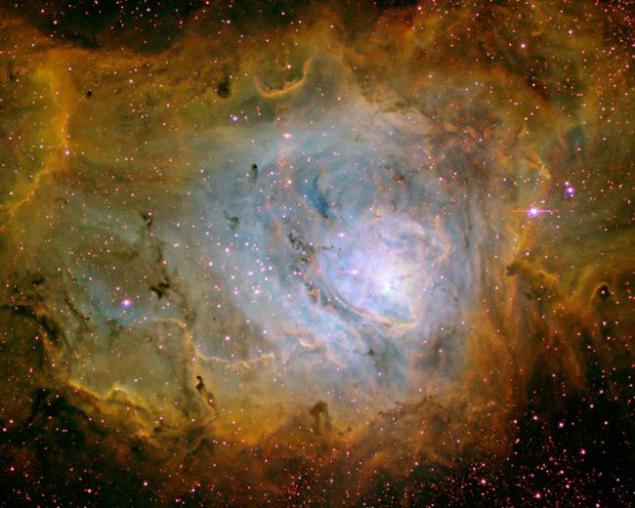
Cat's Eye Nebula
Cat's Eye Nebula - is one of the best known planetary nebulae in the sky. Her catchy symmetrical shapes are seen in the central part of this spectacular false-color image, specially treated to a great show, but very faint halo of gaseous material having a diameter of about three light years.

Constellation Chameleon
Small constellation Chameleon is located near the south pole of the World. The picture reveals the amazing features of the modest constellation, which found a lot of dust nebulae and colorful stars. On the field scattered blue reflection nebulae.
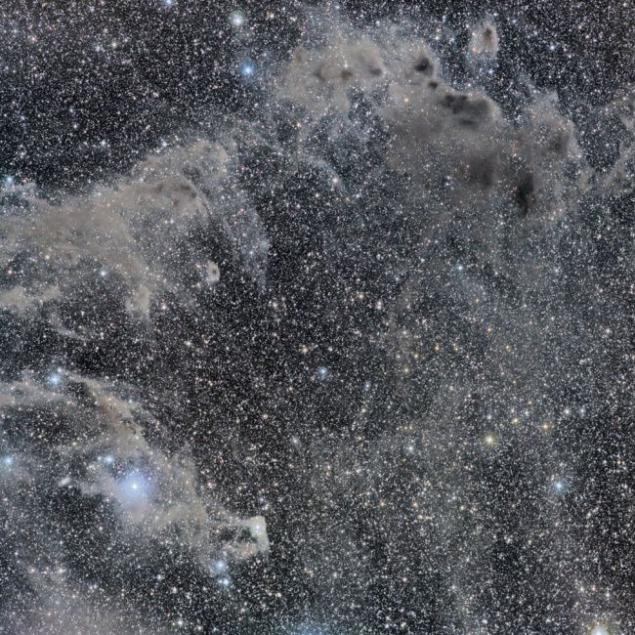
Nebula Sh2-136
Cosmic dust clouds, glowing faintly reflected starlight, hiding on the edge of the complex molecular cloud Cepheus Halo, remote from us at 1,200 light-years.
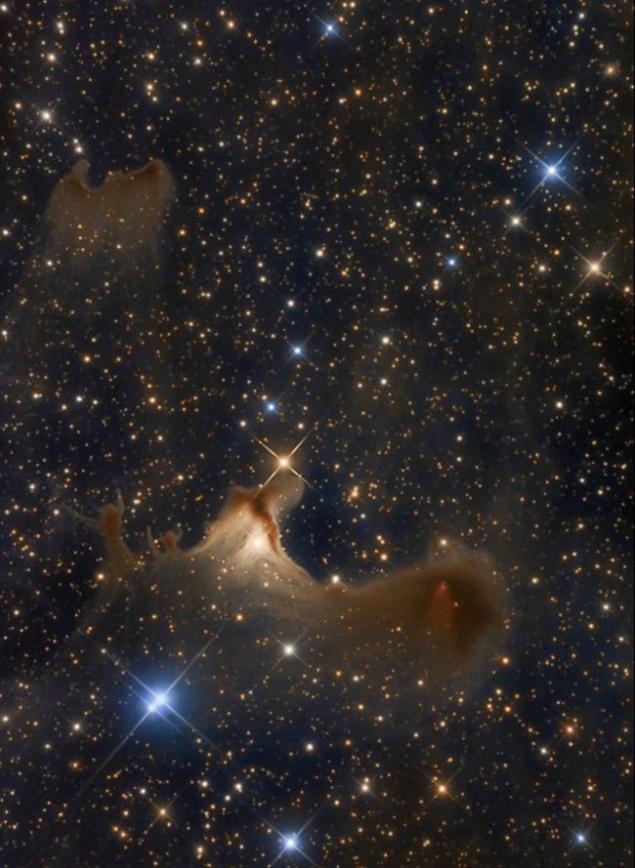
The Crab Nebula
This confusion remained after the explosion of the star. The Crab Nebula is the result of a supernova explosion that was observed in 1054 AD. The supernova remnant is filled with mysterious filaments. The Crab Nebula is ten light years. In the center of the nebula is a pulsar - a neutron star with a mass equal to the mass of the Sun, which is only the size of a small town.

Mirage of gravitational lens
This mirage of a gravitational lens. Depicted in this photo bright red galaxy distorted its gravity light from more distant blue galaxy. Most often, such a distortion of light leads to the appearance of the two images distant galaxy, but in the case of very precise overlay galaxies and gravitational lens images merge into a horseshoe - almost closed ring. This effect was predicted by Albert Einstein more 70 years ago.
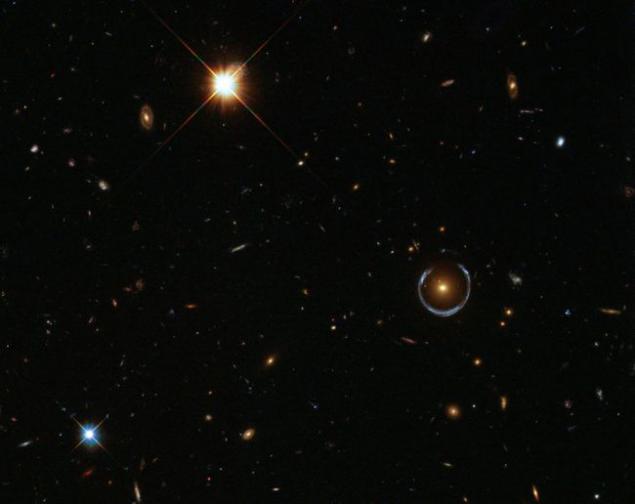
Star V838 Mon
For unknown reasons, in January 2002, the outer shell of the star V838 Mon suddenly widened, making it the brightest star in the entire Milky Way. Then she also suddenly become weak. Astronomers had never seen such an outbreak.
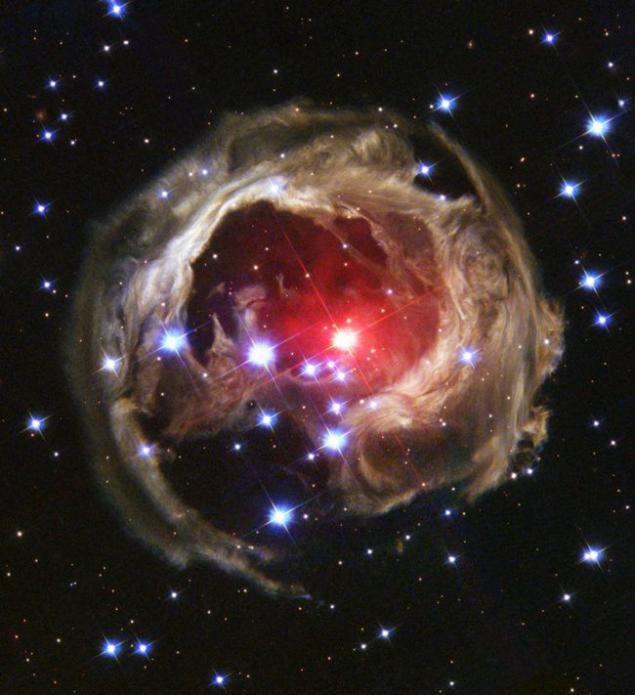
The birth of planets
How do planets form? To help find out, the Hubble Space Telescope was tasked to look closely at one of the most interesting of all the nebulae in the sky - Great Nebula in Orion. The Orion Nebula can be seen with the naked eye near the belt of the constellation Orion. Tie-in this photo show numerous proplyds, many of them - is a stellar nursery, where probably are emerging planetary systems.

Star Cluster R136
In the center of star-forming region Doradus lies a huge cluster of the largest, hottest, among all the massive stars known. These stars form a cluster, captured in this image.

Galaxy Silver Dollar
Shiny NGC 253 is one of the brightest spiral galaxies that we see, and at the same time one of the most dusty. Some call it the "Galaxy Silver Dollar." Others call it simply "galaxy in Sculptor", because it is within the southern constellation Sculptor. This dusty galaxy is located 10 million light-years away.
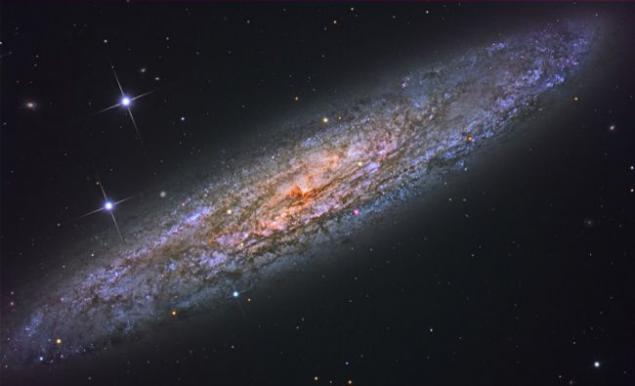
Galaxy M83
One of the closest spiral galaxies to us. From a distance that separates us from it of 15 million light-years, it looks completely normal. However, if we look in more detail at the center of M83 using the largest telescopes, this area is brought before us rapid and noisy place.
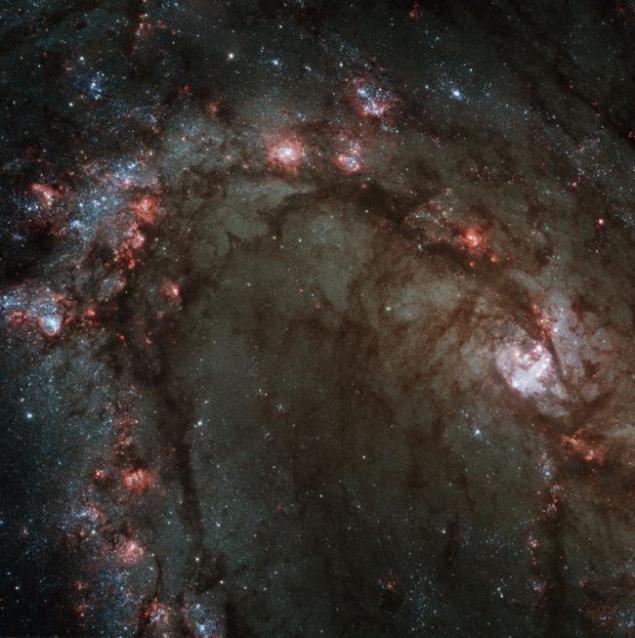
Ring Nebula
She really looks like a ring in the sky. Therefore, even a hundred years ago, astronomers called this nebula according to its unusual shape. It belongs to a class of planetary nebulae. This gas clouds that emit a star similar to the sun at the end of his life. One of the earliest images of the Hubble.
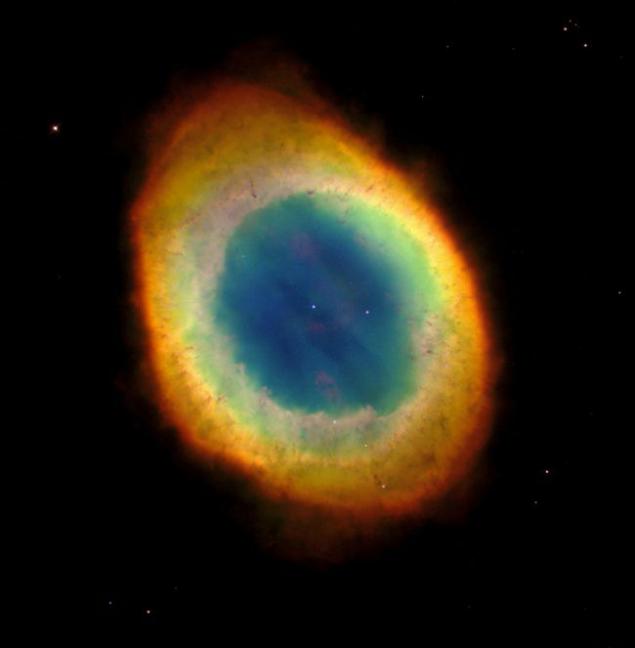
Pillar and Jets in the Carina Nebula
This cosmic gas and dust pillar has a width of two light years. The structure is located in one of the most important regions of star formation in our galaxy, the Carina Nebula, which is visible in the southern sky and lies about 7500 light-years.
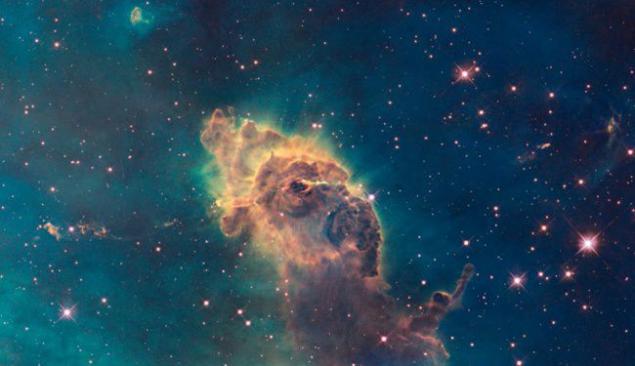
Center of the globular cluster Omega Centauri
In the center of the globular cluster Omega Centauri star packed ten thousand times denser than in the solar neighborhood. The image shows many weak yellow-white stars, smaller than our sun, a few orange red giants, as well as random blue stars. If suddenly two stars collide, may form one more massive star, or they form a new dual system.
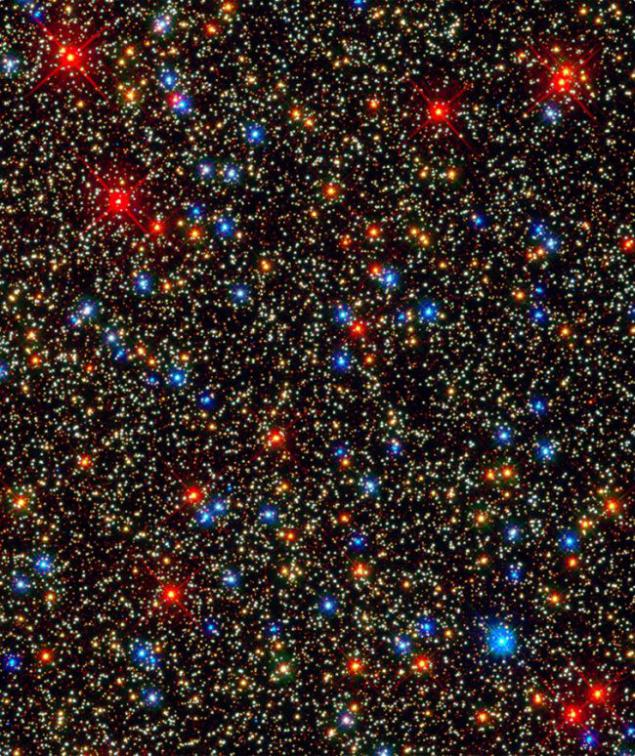
Huge cluster distorts the image of the galaxy and splits
This is an image of a single unusual, like a necklace, a ring-shaped blue galaxy, which by chance was located behind a giant cluster of galaxies. According to recent studies, only the picture can be found at least 330 separate images of distant galaxies. This beautiful picture was taken the Hubble Space Telescope in November 2004.

Trifid
Multicoloured Trifid lets you explore space contrasts. Also known as M20, it is at a distance of about 5000 light years away in the nebula rich constellation Sagittarius. The size of the nebula - about 40 light-years.
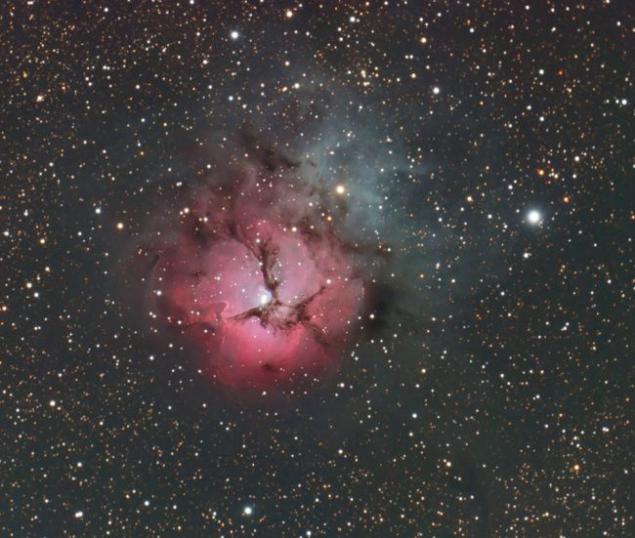
Centaurus A
Fantastic bunch of young blue star clusters, gigantic glowing gas clouds and dark dust lanes surrounds the central region of the active galaxy Centaurus A. Centaurus A is close to the Earth at a distance of 10 million light-years.
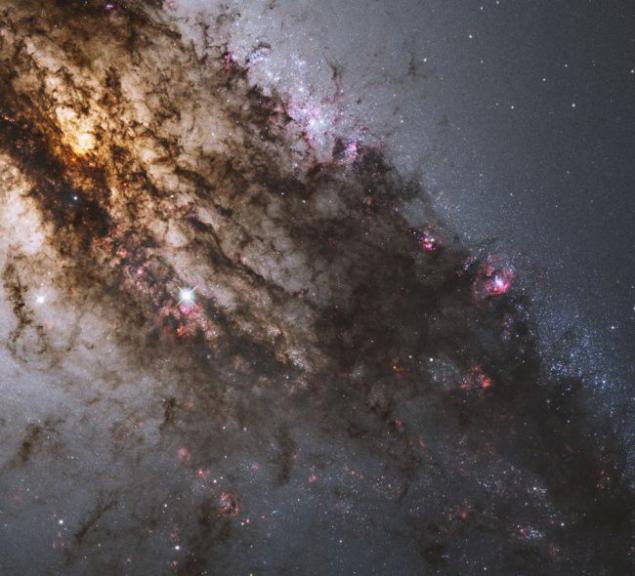
Butterfly Nebula
Bright clusters and nebulae in the night sky of the planet Earth are often given names by the names of flowers or insects, and the nebula NGC 6302 is no exception. The central star of a planetary nebula extremely hot temperature of its surface is about 250 thousand degrees Celsius.

Supernova
The image of a supernova that exploded in 1994 on the outskirts of a spiral galaxy.
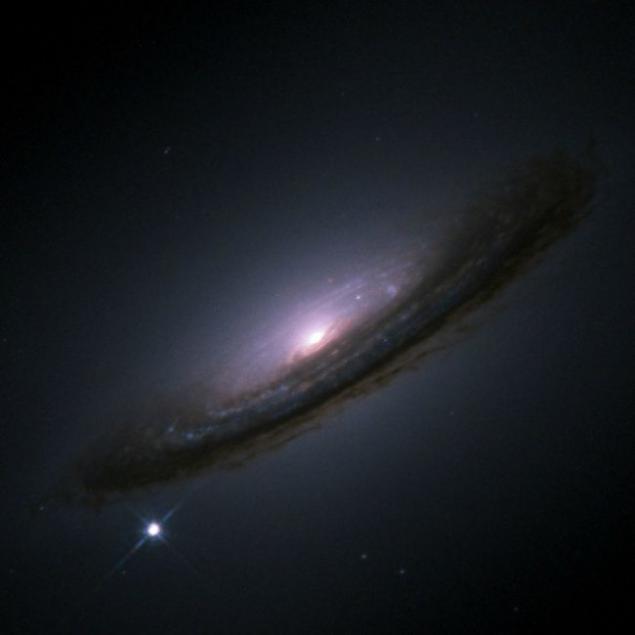
Two colliding galaxies with spiral arms fused
On this remarkable cosmic portrait shows two colliding galaxies merged with spiral arms. Above and to the left of the large spiral galaxy can be seen a third galaxy, which is also likely to be involved in the interaction. All of these galaxies are located about 450 million light-years away in the galaxy cluster in Hercules. At this distance the image spans more than 150 thousand light-years. And although this type seems very unusual, scientists now know that the collision and subsequent merger of galaxies are not uncommon.

Spiral galaxy NGC 3521
Spiral galaxy NGC 3521 is located only 35 million light-years away toward the constellation of Leo. Galaxies, stretches for 50 thousand light years, has features such as spiral arms torn irregularly shaped, decorated with dust, pinkish star forming regions and clusters of bluish young stars.
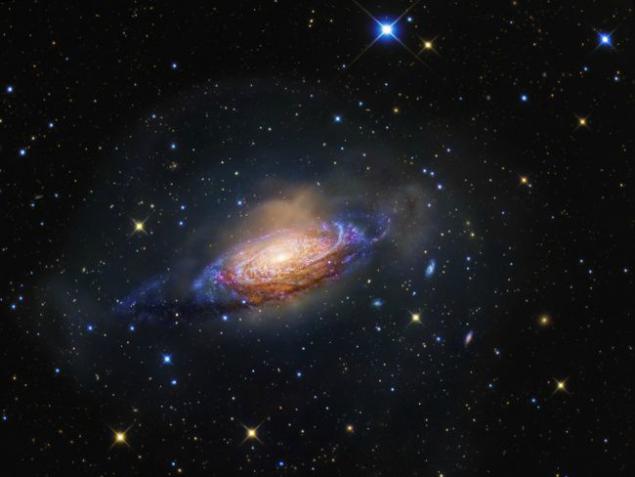
Sombrero Galaxy
Type M104 galaxy resembles a hat, so it was named Sombrero Galaxy. In the picture show distinct dark dust lanes and bright halo of stars and globular clusters. Reasons for the Sombrero galaxy similar to the hat - an unusually large central bulge stellar and dense dark dust lanes that are in the disk of the galaxy, we see nearly edge
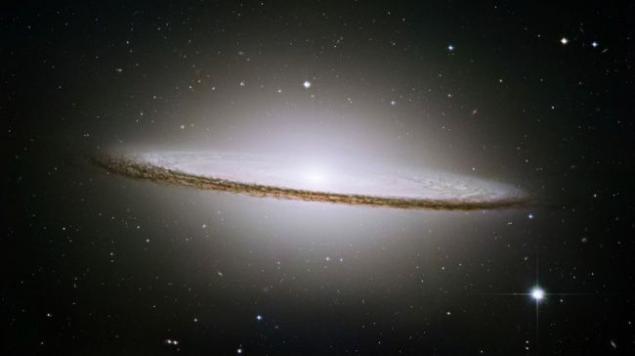
M17: a close-up view of
Formed by stellar winds and radiation, these fantastic, like a wave of education are in the Omega nebula and enter into star-forming region. The Omega Nebula is in the nebula rich constellation Sagittarius and removed to a distance of 5500 light years. Ragged thickening dense and cold gas and dust are illuminated by radiation of stars in the image at the top right, in the future they may become places of star formation.

Nebula IRAS 05437 + 2502
It is unknown what this highlights the nebula. Particularly enigmatic arc appears bright in an inverted V, which delineates the top edge of mountains similar interstellar dust cloud located near the center of the image. In general, this resembles a ghost nebula involves a small star forming region filled with dark dust. It was first seen in images taken IRAS satellite in infrared light in 1983. This shows a remarkable, recently published images, the Hubble Space Telescope. Although it is clear, and many new items, the cause of the bright, clear arc could not be determined.
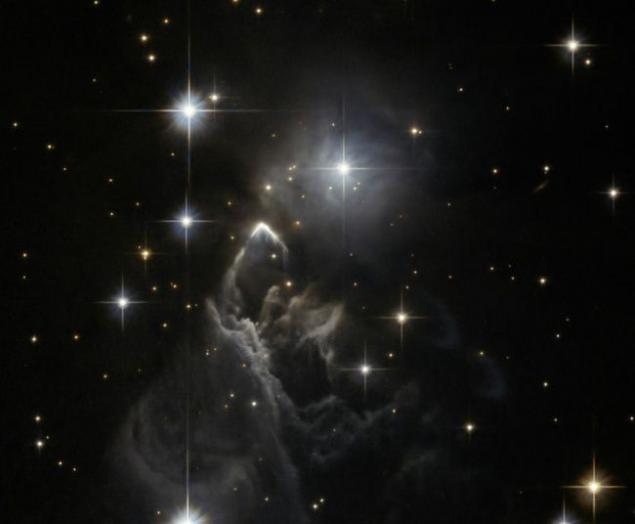
Horsehead Nebula
Hubble team annually produces stunning picture to celebrate the anniversary of the launch of the Space Telescope April 24, 1990. This time they are presented to the world famous photograph of the nebula "Horsehead", which is in the constellation of Orion 1500 light years from Earth.
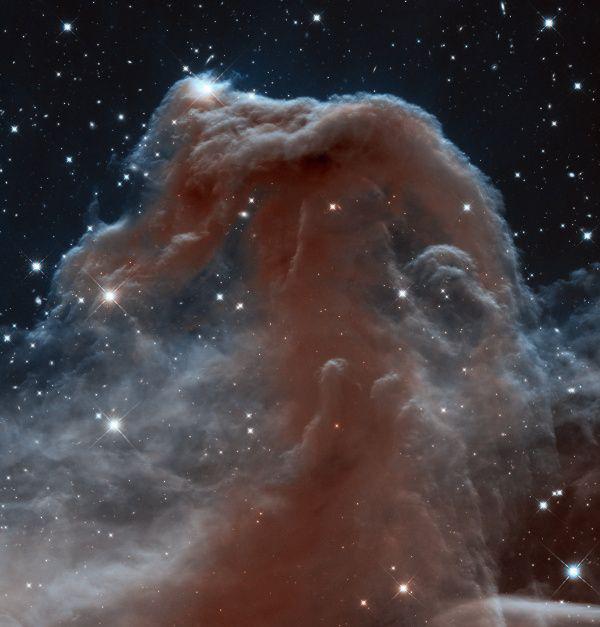
Source: www.softmixer.com
This large galaxy may have been the original spiral nebula. It is clearly seen that her arms and dust band pass in front of satellite galaxies (left). This pair is located about 31 million light-years and officially belongs to the small constellation Canes Venatici.

Spiral Galaxy M33
The average size galaxy M33 is also called the Triangulum Galaxy for the constellation in which it resides. It is about 4 times smaller in radius than our Milky Way Galaxy and the Andromeda Galaxy. M33 is close to the Milky Way, its angular size of twice the size of the full moon, and it is perfectly visible with good binoculars.

Stephan's Quintet
This group of galaxies called Stephan's Quintet. However, only four galaxies of the group are located in three hundred million light-years from us, participate in the cosmic dance, then approaching, remove from each other. Excess find quite simple. Four interacting galaxies have a yellowish tint and curved loops and tails, the shape of which is due to the influence of the devastating tidal gravitational forces. Bluish galaxy is located on the top left of the picture is much closer than the others, just 40 million light years from us.

Andromeda Galaxy
Andromeda Galaxy - the closest to our own Milky Way from giant galaxies. Most likely, our galaxy looks about the same as this one. Hundreds of billions of stars that make up the Andromeda galaxy, together give a visible diffuse glow. Individual stars in the image are actually stars in our galaxy located much closer to the remote object.

The Lagoon Nebula
In bright Lagoon Nebula is a wide variety of astronomical objects. Particularly interesting objects are bright open cluster of stars and a few active regions of star formation.

Cat's Eye Nebula
Cat's Eye Nebula - is one of the best known planetary nebulae in the sky. Her catchy symmetrical shapes are seen in the central part of this spectacular false-color image, specially treated to a great show, but very faint halo of gaseous material having a diameter of about three light years.

Constellation Chameleon
Small constellation Chameleon is located near the south pole of the World. The picture reveals the amazing features of the modest constellation, which found a lot of dust nebulae and colorful stars. On the field scattered blue reflection nebulae.

Nebula Sh2-136
Cosmic dust clouds, glowing faintly reflected starlight, hiding on the edge of the complex molecular cloud Cepheus Halo, remote from us at 1,200 light-years.

The Crab Nebula
This confusion remained after the explosion of the star. The Crab Nebula is the result of a supernova explosion that was observed in 1054 AD. The supernova remnant is filled with mysterious filaments. The Crab Nebula is ten light years. In the center of the nebula is a pulsar - a neutron star with a mass equal to the mass of the Sun, which is only the size of a small town.

Mirage of gravitational lens
This mirage of a gravitational lens. Depicted in this photo bright red galaxy distorted its gravity light from more distant blue galaxy. Most often, such a distortion of light leads to the appearance of the two images distant galaxy, but in the case of very precise overlay galaxies and gravitational lens images merge into a horseshoe - almost closed ring. This effect was predicted by Albert Einstein more 70 years ago.

Star V838 Mon
For unknown reasons, in January 2002, the outer shell of the star V838 Mon suddenly widened, making it the brightest star in the entire Milky Way. Then she also suddenly become weak. Astronomers had never seen such an outbreak.

The birth of planets
How do planets form? To help find out, the Hubble Space Telescope was tasked to look closely at one of the most interesting of all the nebulae in the sky - Great Nebula in Orion. The Orion Nebula can be seen with the naked eye near the belt of the constellation Orion. Tie-in this photo show numerous proplyds, many of them - is a stellar nursery, where probably are emerging planetary systems.

Star Cluster R136
In the center of star-forming region Doradus lies a huge cluster of the largest, hottest, among all the massive stars known. These stars form a cluster, captured in this image.

Galaxy Silver Dollar
Shiny NGC 253 is one of the brightest spiral galaxies that we see, and at the same time one of the most dusty. Some call it the "Galaxy Silver Dollar." Others call it simply "galaxy in Sculptor", because it is within the southern constellation Sculptor. This dusty galaxy is located 10 million light-years away.

Galaxy M83
One of the closest spiral galaxies to us. From a distance that separates us from it of 15 million light-years, it looks completely normal. However, if we look in more detail at the center of M83 using the largest telescopes, this area is brought before us rapid and noisy place.

Ring Nebula
She really looks like a ring in the sky. Therefore, even a hundred years ago, astronomers called this nebula according to its unusual shape. It belongs to a class of planetary nebulae. This gas clouds that emit a star similar to the sun at the end of his life. One of the earliest images of the Hubble.

Pillar and Jets in the Carina Nebula
This cosmic gas and dust pillar has a width of two light years. The structure is located in one of the most important regions of star formation in our galaxy, the Carina Nebula, which is visible in the southern sky and lies about 7500 light-years.

Center of the globular cluster Omega Centauri
In the center of the globular cluster Omega Centauri star packed ten thousand times denser than in the solar neighborhood. The image shows many weak yellow-white stars, smaller than our sun, a few orange red giants, as well as random blue stars. If suddenly two stars collide, may form one more massive star, or they form a new dual system.

Huge cluster distorts the image of the galaxy and splits
This is an image of a single unusual, like a necklace, a ring-shaped blue galaxy, which by chance was located behind a giant cluster of galaxies. According to recent studies, only the picture can be found at least 330 separate images of distant galaxies. This beautiful picture was taken the Hubble Space Telescope in November 2004.

Trifid
Multicoloured Trifid lets you explore space contrasts. Also known as M20, it is at a distance of about 5000 light years away in the nebula rich constellation Sagittarius. The size of the nebula - about 40 light-years.

Centaurus A
Fantastic bunch of young blue star clusters, gigantic glowing gas clouds and dark dust lanes surrounds the central region of the active galaxy Centaurus A. Centaurus A is close to the Earth at a distance of 10 million light-years.

Butterfly Nebula
Bright clusters and nebulae in the night sky of the planet Earth are often given names by the names of flowers or insects, and the nebula NGC 6302 is no exception. The central star of a planetary nebula extremely hot temperature of its surface is about 250 thousand degrees Celsius.

Supernova
The image of a supernova that exploded in 1994 on the outskirts of a spiral galaxy.

Two colliding galaxies with spiral arms fused
On this remarkable cosmic portrait shows two colliding galaxies merged with spiral arms. Above and to the left of the large spiral galaxy can be seen a third galaxy, which is also likely to be involved in the interaction. All of these galaxies are located about 450 million light-years away in the galaxy cluster in Hercules. At this distance the image spans more than 150 thousand light-years. And although this type seems very unusual, scientists now know that the collision and subsequent merger of galaxies are not uncommon.

Spiral galaxy NGC 3521
Spiral galaxy NGC 3521 is located only 35 million light-years away toward the constellation of Leo. Galaxies, stretches for 50 thousand light years, has features such as spiral arms torn irregularly shaped, decorated with dust, pinkish star forming regions and clusters of bluish young stars.

Sombrero Galaxy
Type M104 galaxy resembles a hat, so it was named Sombrero Galaxy. In the picture show distinct dark dust lanes and bright halo of stars and globular clusters. Reasons for the Sombrero galaxy similar to the hat - an unusually large central bulge stellar and dense dark dust lanes that are in the disk of the galaxy, we see nearly edge

M17: a close-up view of
Formed by stellar winds and radiation, these fantastic, like a wave of education are in the Omega nebula and enter into star-forming region. The Omega Nebula is in the nebula rich constellation Sagittarius and removed to a distance of 5500 light years. Ragged thickening dense and cold gas and dust are illuminated by radiation of stars in the image at the top right, in the future they may become places of star formation.

Nebula IRAS 05437 + 2502
It is unknown what this highlights the nebula. Particularly enigmatic arc appears bright in an inverted V, which delineates the top edge of mountains similar interstellar dust cloud located near the center of the image. In general, this resembles a ghost nebula involves a small star forming region filled with dark dust. It was first seen in images taken IRAS satellite in infrared light in 1983. This shows a remarkable, recently published images, the Hubble Space Telescope. Although it is clear, and many new items, the cause of the bright, clear arc could not be determined.

Horsehead Nebula
Hubble team annually produces stunning picture to celebrate the anniversary of the launch of the Space Telescope April 24, 1990. This time they are presented to the world famous photograph of the nebula "Horsehead", which is in the constellation of Orion 1500 light years from Earth.

Source: www.softmixer.com

